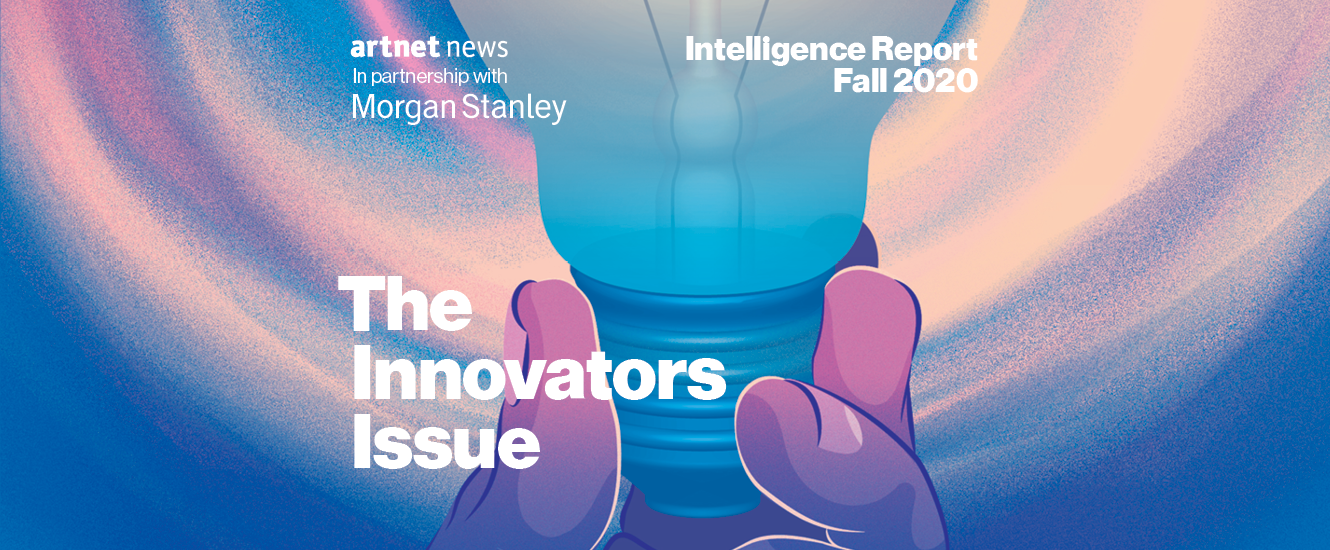
[Click here to download the full report]
The COVID-19 pandemic has forced the art world to reckon with quite a few uncomfortable questions:
How many people will still buy art after the merry-go-round of art-fair vernissages and gallery dinners has stopped? How many cities have the resources to keep their local arts ecosystems intact through a prolonged shutdown? Are the elements that grease the gears of the art market—from social capital to international travel—fundamentally incompatible with social distancing? And, perhaps most importantly, what skills and values do we as an industry need to cultivate in order to survive this challenging chapter?
All these questions will take time to answer. But the fall 2020 Artnet Intelligence Report is dedicated to starting the conversation—and identifying exactly who we should be listening to as it gets underway. That’s why this issue is centered on our inaugural Innovators List: a group of 51 entrepreneurs, artists, dealers, and others who are lighting the way toward the future with vision, chutzpah, and grit.
From the son of a bus driver who is guiding the world’s leading museums into the smartphone age to a scrappy international group of gallerists sharing a single modest storefront in Brussels, the figures on our list prove that the art world can survive—and even thrive—if it embraces technology, collaboration, and transparency.
Inside the report, you will also find an illuminating account of how auction houses have adapted to the social-distancing era (spoiler alert: for one house, it involved hiring a production company that normally specializes in covering extreme sports) and a data-led breakdown of exactly which segments of the market are poised to emerge from lockdown stronger than they were before.
Finally, we will take you inside the thrilling—and sometimes shocking—career trajectory of Amoako Boafo, an artist who has become, at warp speed, one of the art market’s most sought-after talents. The journey that brought him to global prominence is filled with twists and turns, from infighting to backroom deals fueled by greed and ambition—and not even the quarantine has slowed it down.
The stories in this issue prove that the art market of 2020 already looks very different from the one we’ve come to know, with plenty more change to come. Still, we can all count on at least one thing to stay the same in the years ahead: the surest way to get left behind will be to pretend the old rules still apply.
[Click here to download the full report]
— TABLE OF CONTENTS —
– Marketplace
• What sold at the height of the shutdown?
• 3 top collectors on what they buy (and why)
• The top 10 lots of 2020 (so far) in every major category
– The Innovators List
At a time of unprecedented change, we scoured the globe to bring you 51 people who are changing the way the art market functions—and will play a big role in shaping its future.
– What Does a Post-Lockdown Auction House Look Like? by Eileen Kinsella
The global shutdown threw the live auction business into disarray, depleting traditional houses of expected revenue. Here’s how they’re evolving to survive.
– The Swift, Cruel, Incredible Rise of Amoako Boafo by Nate Freeman
The Ghanaian painter has become the art industry’s newest obsession. Now, he’s committed to seizing control of his own market.
– Here’s What Really Happened to the Art Market During Lockdown by Julia Halperin
• Which country’s art market was hardest hit?
• What price points proved most resilient?
• Who are today’s most bankable artists?
– Art Is an Asset. Here’s How to Make Sure It Works for You in Partnership With the ART Resources Team at Morgan Stanley
• A guide to how the art market relates to financial markets
• Morgan Stanley’s ART Resources Team on how to integrate art into your portfolio
— KEY FINDINGS —
© Artnet Price Database.
- A grand total of $2.9 billion worth of fine art sold at auction in the first half of 2020, down a hefty 58.3 percent from the equivalent period in 2019.
- The lockdown made it less appealing to consign art for sale, bringing down the number of works offered by almost 30 percent.
- The objects that did sell were less expensive than in the past. The average price of a work of fine art fell 41.3 percent in the first half of 2020 compared with the same period last year.
- The world’s three largest art markets—the US, the UK, and China—were all hurt by the shutdown, but not equally. China’s total fine-art auction sales plummeted a stunning 84.9 percent, while the UK and the US each dropped “only” 52 percent year-over-year.
- A total of $186.4 million worth of art was sold online at Phillips, Sotheby’s, and Christie’s in the first half of 2020, compared to just $32.4 million in the equivalent period in 2019—a whopping 474.8 percent increase.
- Ultra-contemporary art—our term for work by artists born after 1974—remains smaller than any other sector, but it was also the least affected by the shutdown. Total sales in the category declined by 22.4 percent compared to the equivalent period in 2019, while sales in every other category shrank at least twice as much.
- The lower end of the market proved most resilient in the first half of 2020. Sales of work up to $10,000 declined 27.9 percent, the smallest step down of any price bracket.
- Among all genres and price points, the most dramatic dip came in the elite $10 million-and-up slice of the Impressionist and Modern market, which sank by 69.6 percent as many consignors opted to sell their best material privately or wait to put it on the market.